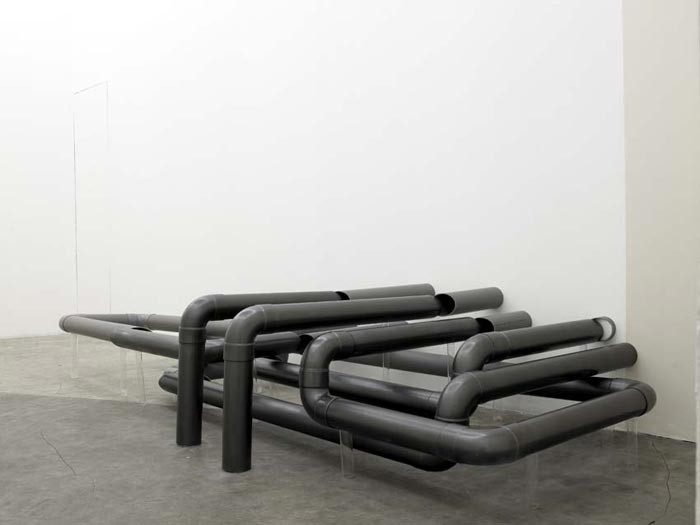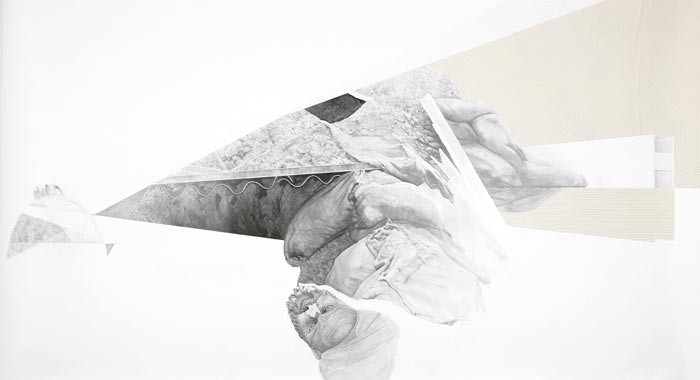Alison Moffett
10 May - 16 Jun 2007

© Alison Moffett, courtesy galerie schleicher+lange, Paris
'Through Titanium and Lead', 2007, pencil on paper, 389 x 239 cm
'Through Titanium and Lead', 2007, pencil on paper, 389 x 239 cm

© Alison Moffett, courtesy galerie schleicher+lange, Paris
'repeat to end' installation view (photo © Marc Domage)
'repeat to end' installation view (photo © Marc Domage)

© Alison Moffett, courtesy galerie schleicher+lange, Paris
'repeat to end' installation view (photo © Marc Domage)
'repeat to end' installation view (photo © Marc Domage)

© Alison Moffett, courtesy galerie schleicher+lange, Paris
'The End of History', 2007, pencil on paper, 125 x 227,5 cm (photo © Marc Domage)
'The End of History', 2007, pencil on paper, 125 x 227,5 cm (photo © Marc Domage)

© Alison Moffett, courtesy galerie schleicher+lange, Paris
'As before', 2007, pencil on draft film, 47 x 34,5 cm
'As before', 2007, pencil on draft film, 47 x 34,5 cm

© Alison Moffett, courtesy galerie schleicher+lange, Paris
‘Hollow’, 2007, acrylic paint on canvas, paper, pencil, perspex, 121 x 92 cm
‘Hollow’, 2007, acrylic paint on canvas, paper, pencil, perspex, 121 x 92 cm
Alison Moffett: repeat to end
Following her participation in two group exhibitions at the gallery, galerie schleicher+lange is pleased to announce the first solo show by American artist Alison Moffet (*1979).
Conceived especially for the occasion, the artist created a new body of work around concepts of de-construced space and non-linear perception of time and history.
Moffett’s latest large scale drawing Through titanium and lead mixes references to the
history of architecture, from the antique to the international style and constructivism - as
well as to science-fiction. Confronting different civilizations that have followed each other
through history, she juxtaposes elements of Hadrian’s Villa with distinctly modernist forms
and situates the whole in space that defies the laws of physics. One occurrence in space and time ties itself to another – each influencing the other until the boundary lines blur and a new reality locks into place.
By introducing collaged elements of paper cut in geometric shapes and painted in either
black ink or white acrylic paint, the artist opens up the composition to an undefined transitional space.
Similar artistic strategies can be found in the painting Hollow. Depicting an empty interior
space in a minimalist fashion, an extremely detailed drawing on paper of a wooden stage has been cut-out and stuck on the canvas, as if having been produced by the gaze of the spectator.
A piece of black perspex takes the space of the shadow of this platform and continues
over the limits of the canvas and onto the wall, thus breaking open the space the work has been confined to. A more linear structure can be found in the drawing As before. Drawn on superimposed layers of draft film, different objects that have been looted from the museum of Bagdad, seem to disappear with every added layer, in the same way these objects might have ‘disappeared from history’.
Like a logical continuation of her analysis of space and time on a two- dimensional surface, Alison Moffett has created for the first time a site specific sculptural installation that pushes the ideas and concepts of her drawings even further, while staying in dialogue with them.
In repeat to end, a complex system of plumbing seems to ‘grow’ from the gallery’s floor, as if left after an archeological dig. The pipes reveal a kind of continuity of an exchange, interrupted by numerous breaking points in a seemingly homogeneous unity. However they are split into two similar entities that destinct themselves through a slight optical, physical and chromatic difference that creates a discordance between two areas that both have their specific time-spaces realities, underlined by the contrast of color and texture that refer back to the different temporalities. Similarly on the opposite side of the room, a copper pipe comes out of the wall, runs around a door that is not actually there, and re-enters the wall. Again the space seems to have shifted in a strange way. Instead of the opening indicated by the shape of the pipe there is only a solid wall, an impossible passage. Aside from the way the sculpture refers to the perception of space, time again becomes an important issue. The copper being treated in a special way results in a part of the object staying pristine while another part is subject to accelerated oxidization that takes place during the exhibition. The two parts of the same object are therefore subtly situated in two different time spaces.
Following her participation in two group exhibitions at the gallery, galerie schleicher+lange is pleased to announce the first solo show by American artist Alison Moffet (*1979).
Conceived especially for the occasion, the artist created a new body of work around concepts of de-construced space and non-linear perception of time and history.
Moffett’s latest large scale drawing Through titanium and lead mixes references to the
history of architecture, from the antique to the international style and constructivism - as
well as to science-fiction. Confronting different civilizations that have followed each other
through history, she juxtaposes elements of Hadrian’s Villa with distinctly modernist forms
and situates the whole in space that defies the laws of physics. One occurrence in space and time ties itself to another – each influencing the other until the boundary lines blur and a new reality locks into place.
By introducing collaged elements of paper cut in geometric shapes and painted in either
black ink or white acrylic paint, the artist opens up the composition to an undefined transitional space.
Similar artistic strategies can be found in the painting Hollow. Depicting an empty interior
space in a minimalist fashion, an extremely detailed drawing on paper of a wooden stage has been cut-out and stuck on the canvas, as if having been produced by the gaze of the spectator.
A piece of black perspex takes the space of the shadow of this platform and continues
over the limits of the canvas and onto the wall, thus breaking open the space the work has been confined to. A more linear structure can be found in the drawing As before. Drawn on superimposed layers of draft film, different objects that have been looted from the museum of Bagdad, seem to disappear with every added layer, in the same way these objects might have ‘disappeared from history’.
Like a logical continuation of her analysis of space and time on a two- dimensional surface, Alison Moffett has created for the first time a site specific sculptural installation that pushes the ideas and concepts of her drawings even further, while staying in dialogue with them.
In repeat to end, a complex system of plumbing seems to ‘grow’ from the gallery’s floor, as if left after an archeological dig. The pipes reveal a kind of continuity of an exchange, interrupted by numerous breaking points in a seemingly homogeneous unity. However they are split into two similar entities that destinct themselves through a slight optical, physical and chromatic difference that creates a discordance between two areas that both have their specific time-spaces realities, underlined by the contrast of color and texture that refer back to the different temporalities. Similarly on the opposite side of the room, a copper pipe comes out of the wall, runs around a door that is not actually there, and re-enters the wall. Again the space seems to have shifted in a strange way. Instead of the opening indicated by the shape of the pipe there is only a solid wall, an impossible passage. Aside from the way the sculpture refers to the perception of space, time again becomes an important issue. The copper being treated in a special way results in a part of the object staying pristine while another part is subject to accelerated oxidization that takes place during the exhibition. The two parts of the same object are therefore subtly situated in two different time spaces.
